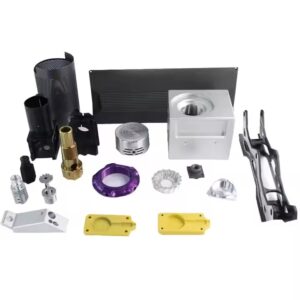Exploring Continuous Stamping Dies: Unveiling the Core Concepts
Amidst the realm of contemporary manufacturing, the paramount trifecta comprises efficiency, precision, and velocity. In this milieu, Continuous Stamping Dies, an oft-neglected yet supremely indispensable element, emerge as the linchpin for attaining these objectives. Within the confines of this discourse, we shall embark on an in-depth exploration of the fundamental tenets underpinning Continuous Stamping Dies, dissecting their constituent elements, functionalities, merits, and practical manifestations in the tangible world.
1. Introduction
A. What is a Continuous Stamping Die?
The Continuous Stamping Die, alternatively recognized as a progressive die, stands as a specialized instrument harnessed in the manufacturing domain for the meticulous shaping and precision cutting of materials. It takes the form of a sequence of interlinked dies operating cohesively, executing a multitude of tasks within a solitary stroke. Among these tasks, one finds cutting, bending, drawing, and coining, endowing it with indispensability across a spectrum of industries.
B. Importance in Modern Manufacturing
Continuous Stamping Dies have ushered in a paradigm shift within contemporary manufacturing by substantially augmenting production efficiency and curtailing expenses. Their aptitude to execute a plethora of tasks in a singular pass not only curtails material wastage but also amplifies productivity, rendering them irreplaceable in the fiercely competitive terrain of modern manufacturing.
2. Components of a Continuous Stamping Die
To understand how Continuous Stamping Dies work, let’s break down their key components:
A. Die Plate
The die plate is the foundation of the stamping die. It holds all the other components in place and provides stability during the stamping process. It’s typically made from high-quality steel to withstand the immense pressure and forces involved.
B. Punches and Holders
Punches and holders are responsible for shaping and cutting the material. The punches create the desired shapes, while the holders ensure precision and consistency throughout the process.
C. Stripper Plate
The stripper plate helps remove the stamped material from the punches after each stroke. This ensures that the material does not stick to the punches and disrupt the continuous stamping process.
D. Die Set
The die set houses the die components and ensures their alignment and movement during operation. It plays a crucial role in maintaining the accuracy of the stamped parts.
E. Feeding Mechanism
The feeding mechanism is responsible for continuously supplying material to the stamping die. It ensures a consistent and uninterrupted production process.
3. How Continuous Stamping Dies Work

A. Step-by-Step Process
Let’s take a closer look at the step-by-step process of continuous stamping:
1. Feeding Material
The process begins with the feeding mechanism supplying a continuous strip of material into the stamping die.
2. Blanking
In this step, the die cuts the material into the desired shape. This can range from simple holes to intricate designs.
3. Bending
After blanking, the material may undergo bending to create three-dimensional shapes or angles.
4. Drawing
Drawing, in this context, entails the elongation of the material to give rise to more profound configurations, exemplified by the creation of cups or shells.
5. Coining
Coining, as the concluding phase, entails the compression of the material to attain exact dimensions and surface finishes with meticulous precision.
B. Advantages of Continuous Stamping
Continuous Stamping offers several advantages, including:
- High Efficiency: It can produce parts rapidly, reducing production time.
- Cost-Effective: Minimizes material waste, saving on raw materials.
- Consistency: Ensures uniform quality across a large production run.
4. Types of Continuous Stamping Dies
Continuous Stamping Dies come in various forms, each catering to specific manufacturing needs:
A. Progressive Stamping Dies
Progressive dies are the most common type and perform multiple operations in a linear sequence. They are ideal for high-volume production.
B. Transfer Stamping Dies
Transfer dies facilitate the movement of the component from one station to another, facilitating diverse operations and thereby conferring flexibility upon the manufacturing process.
C. Tandem Stamping Dies
Tandem dies consist of multiple stamping stations working in tandem to create complex parts efficiently.
5. Applications in Various Industries

Continuous Stamping Dies find applications in diverse industries:
A. Automotive Sector
In the automotive industry, these dies are used to manufacture parts like car body panels, brackets, and chassis components.
B. Electronics Industry
Continuous stamping is crucial for producing intricate components used in electronics, such as connectors and switches.
C. Appliance Manufacturing
Home appliances like washing machines and refrigerators often contain parts created using continuous stamping technology.
D. Aerospace
In the aerospace sector, continuous stamping is employed to create lightweight and high-strength components.
6. Case Studies
A. Success Stories
Several manufacturing companies have significantly improved their production processes and reduced costs through the adoption of continuous stamping dies.
B. Real-World Examples
We will explore real-world examples of products created using continuous stamping, showcasing their quality and precision.
7. Frequently Asked Questions (FAQs)
A. What is the lifespan of a continuous stamping die?
The lifespan of a continuous stamping die depends on factors such as usage and maintenance. However, with proper care, it can last for millions of cycles.
B. Can continuous stamping be automated?
Yes, continuous stamping can be fully automated, leading to increased production speed and reduced labor costs.
C. How does continuous stamping impact production speed?
Continuous stamping significantly increases production speed due to its ability to perform multiple operations in one pass.
D. Are continuous stamping dies suitable for small-scale production?
While continuous stamping is often associated with high-volume production, it can also be adapted for small-scale production, offering cost-efficiency and precision.
E. What are the environmental benefits of continuous stamping?
Continuous stamping reduces material waste, making it more environmentally friendly by conserving resources.
F. What industries benefit the most from continuous stamping technology?
Industries characterized by an imperative for high precision, velocity, and efficiency, such as the automotive, electronics, and aerospace sectors, derive the most substantial advantages from the implementation of continuous stamping technology.
8. Conclusion
In summary, continuous stamping dies emerge as the silent champions within the realm of contemporary manufacturing. Their knack for streamlining processes, cost mitigation, and the unwavering maintenance of quality standards renders them indispensable in an array of industries. As technology continues its march forward, we can anticipate the role of continuous stamping in shaping the future of manufacturing to become even more pronounced. Embracing this innovative technology stands as a prerequisite for maintaining competitiveness within the perpetually evolving landscape of manufacturing.




